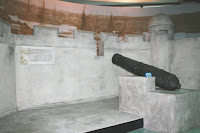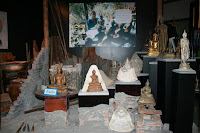 Most tourists who come to Lopburi will only visit the Khmer temple Prang Sam Yot, with the hordes of monkeys stroling around it. That one is of course a place worth visiting if one is not scared of these animals trying to steal almost everything, especially if its something eatable. When going inside the temple one has a very odd view - the monkeys are behind bars, but actually its the monkeys who are in freedom, and the tourists inside the temple are locked away.
Most tourists who come to Lopburi will only visit the Khmer temple Prang Sam Yot, with the hordes of monkeys stroling around it. That one is of course a place worth visiting if one is not scared of these animals trying to steal almost everything, especially if its something eatable. When going inside the temple one has a very odd view - the monkeys are behind bars, but actually its the monkeys who are in freedom, and the tourists inside the temple are locked away.The first time I came to Lopburi - then with a guided tour through the country - we even did not leave the bus as our guide was too scared. I have since returned twice to there, once just taking a closer look at that Prang Sam Yot, but since I want to write about the lesser-known places that other historic site close-by will be the topic.
That place is the palace of King Narai the Great, who made Lopburi a second capital after the main capital of Ayutthaya. The palace was built in 1666, and in fact the king stayed there more time than in the real capital. The reign of King Narai is a very interesting part of the Thai history, as it was the time Siam first got into stronger diplomatic relations with the European powers, especially France. There was a French delegation sent to Siam including Count de Forbin, who unsuccessfully tried to convert the King and thus the country to Catholicism. Also very famous was Constantine Phaulkon, a Greek adventurer who became a highly influential counselor of the king. After King Narai died in 1688, the palace was abandoned, the foreign relation were cut off and Phaulkon was sentenced to death by Phetracha, the usurper who became new king then.
 The palace was restored in the reign of King Mongkut, including the construction of a new throne hall for his stay in 1856. The building, the Phiman Mongkut Pavilion, later became the first provincial hall of Lopburi. 1924 another pavilion was added, serving as a the Lopburi Museum. This museum is now one of the many branch museums of the National Museum of Thailand. Sadly I haven't visited that museum then, as otherwise we would have to skip the sunflower fields scheduled for the afternoon.
The palace was restored in the reign of King Mongkut, including the construction of a new throne hall for his stay in 1856. The building, the Phiman Mongkut Pavilion, later became the first provincial hall of Lopburi. 1924 another pavilion was added, serving as a the Lopburi Museum. This museum is now one of the many branch museums of the National Museum of Thailand. Sadly I haven't visited that museum then, as otherwise we would have to skip the sunflower fields scheduled for the afternoon. But nevertheless, strolling around within the nicely kept ruins of the palace, and at that time the only visitors within the compound makes it a very worthwhile visit, and a great change from the much busier Prang Sam Yot. The place I liked most was at the old throne hall, where they placed the memorial plate depicting King Narai granting an audience to French ambassadors. As usual with everything related to Thai kings, there are garlands hanged around it, and the picture of the king was covered with gold leaves.
But nevertheless, strolling around within the nicely kept ruins of the palace, and at that time the only visitors within the compound makes it a very worthwhile visit, and a great change from the much busier Prang Sam Yot. The place I liked most was at the old throne hall, where they placed the memorial plate depicting King Narai granting an audience to French ambassadors. As usual with everything related to Thai kings, there are garlands hanged around it, and the picture of the king was covered with gold leaves.The next time I get a chance to go to Lopburi, the museum is on my list of places to go, and I also want to take a look at the ruins of Phaulkons residence. There are also several old temples within the historic part of the town, so enough to see for at least one more day-trip.
As the reign of King Narai was quite outstanding and the occurrences at his death marked a turning point in the Thai history, many books are published about it, and I own quite a lot of them. Starting from fictional biographies of Phaulkon, the travel reports of Claude de Forbin, and even a small book deviating from the usually quite negative accounts of Phaulkon's activities.







































